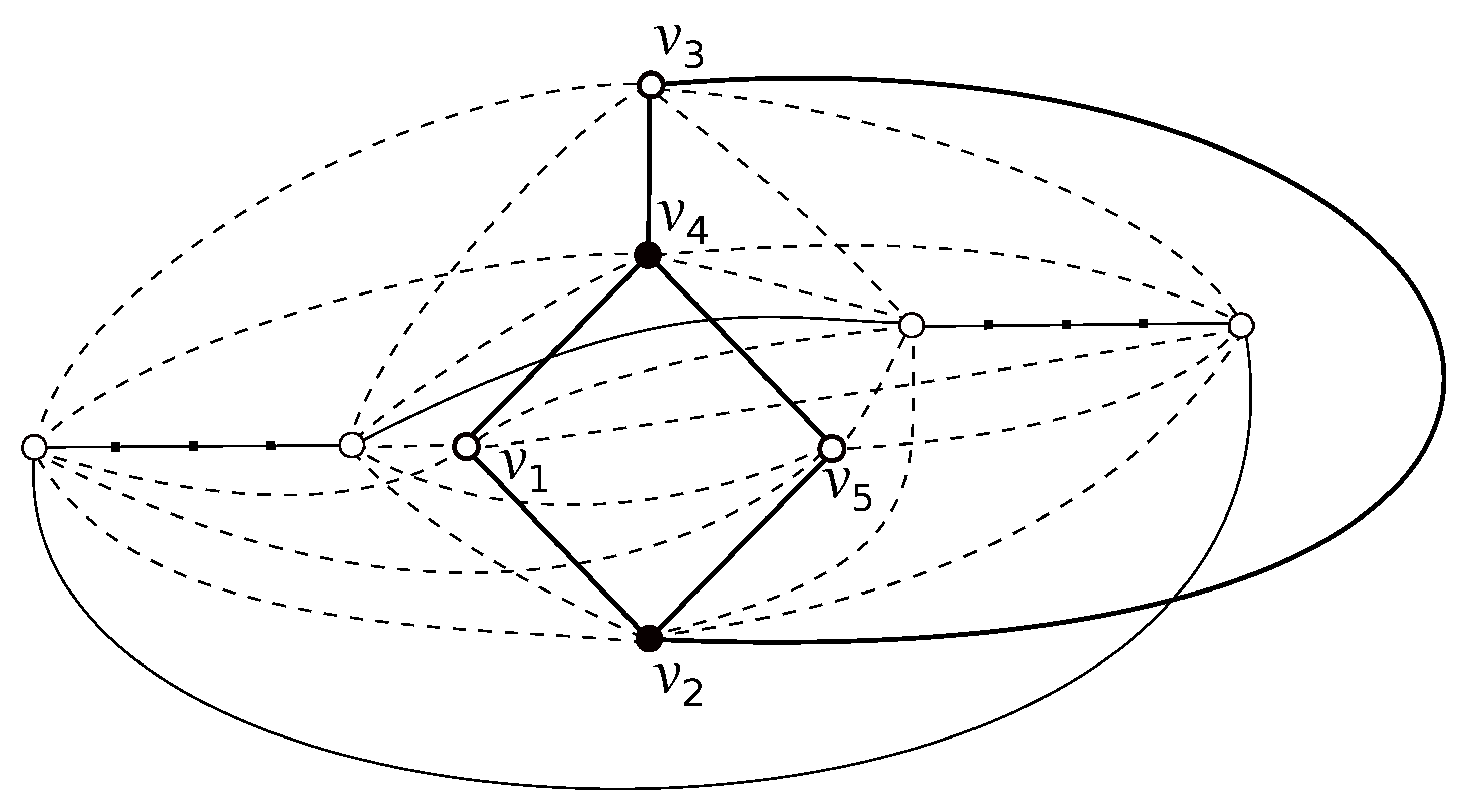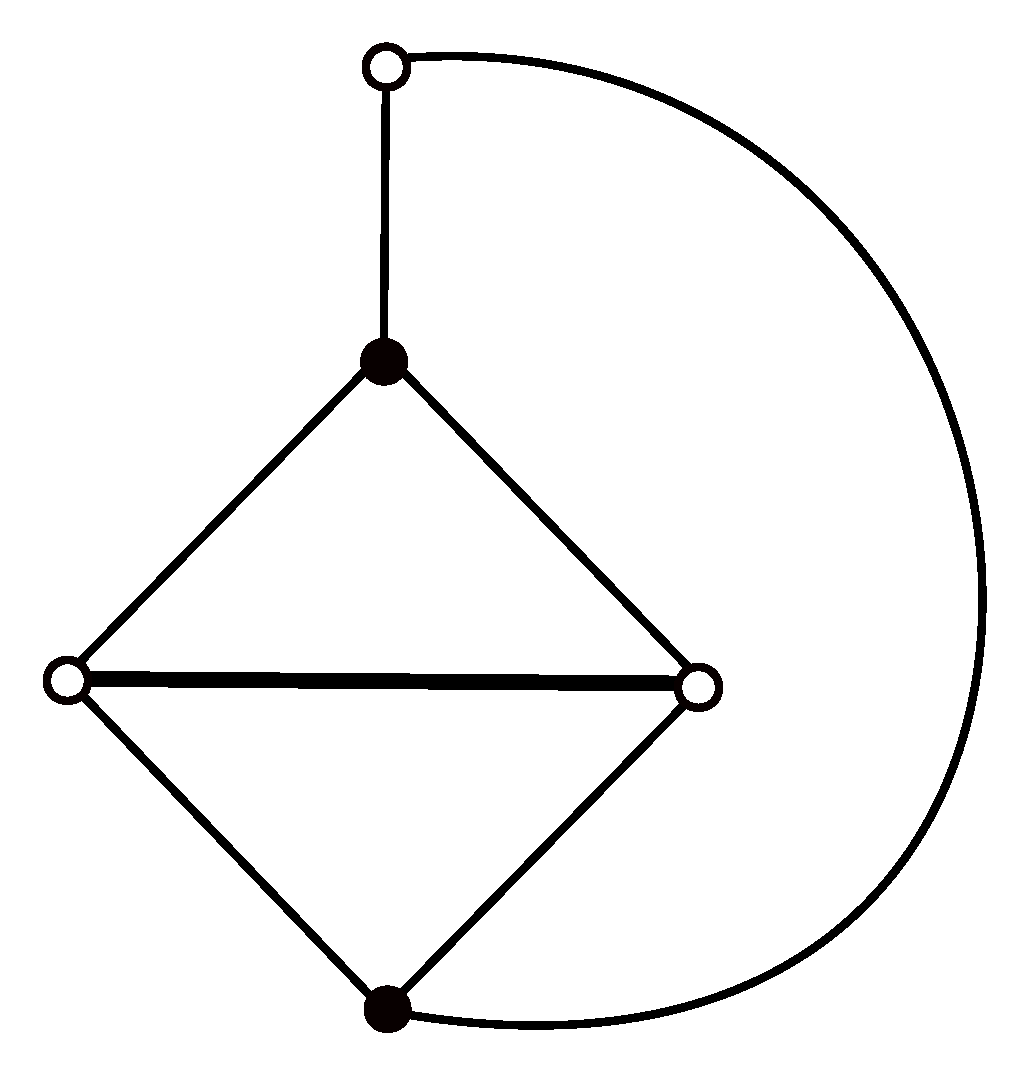Join Products K2,3 + Cn
Abstract
1. Introduction
2. Possible Drawings of and Preliminary Results
3. The Crossing Number of
- (a)
- All vertices of are placed in two regions of subdrawing of induced by D. In the rest of paper, based on their symmetry, we can suppose that all vertices of are placed in . Of course, there is no possibility to obtain a subdrawing of for a , that is, . Clearly, the edges of must cross the edges of exactly twice. This fact, with the property (5) in the form , confirms that , which yields that each subgraph cross the edges of just once. If some vertices of are placed in , then we deal with the configurations , (they have been already introduced in [14]). For , there are four other ways for how to obtain the subdrawing of depending on which edge of is crossed by the edge provided by there is only one subdrawing of represented by the rotation . These four possibilities can be denoted by , for and they are represent by the cyclic permutations , , , and , respectively. Consequently, we denote by the subset of all configurations that exist in the drawing D belonging to the set . Using the same arguments like in [14], the resulting lower bounds for the number of crossings of two configurations from can be established in Table 1 (here, and are configurations of the subgraphs and , where ).Let us first assume that for some . In the rest of paper, let us assume two different subgraphs such that and have different configurations and , respectively. Then, holds for any with by summing the values in all columns in two considered rows of Table 1. Hence, by fixing the subgraph , we haveDue to the symmetry of three remaining pairs of configurations, we also obtain a contradiction in D by applying the same process. Now, let us turn to the good drawing D of the graph in which for any . Further, let us also suppose that the number of subgraphs with the configuration is at least equal to the number of subgraphs with the configuration , for each possible , and let be such a subgraph with the configuration of . Hence,where an idea of the arithmetic mean of the values four, three and two of Table 1 could be exploited. Thus, by fixing the subgraph , we have
- (b)
- All vertices of are placed in the same region of subdrawing of induced by D. In the rest of paper, based also on their symmetry, we suppose that for each . Whereas the set is again empty, there are at least subgraphs provided by the property (5) in the form . For , we consider only one from the configurations , for . Again, let us also assume that the number of subgraphs with the configuration is at least equal to the number of subgraphs with the configuration , for each possible , and let be such a subgraph with the configuration of . Then, by fixing the subgraph , we havewherein a simplified form of the idea of the arithmetic mean of the values of Table 1 is applied.
- (a)
- The cycle is crossed by some edge of the graph . As the edges of cross the edges of exactly twice, there is a subgraph which does not cross the edges of provided by the property (5) in the form . For a , the reader can easily verify that the subgraph is uniquely represented by , and holds for any with provided that , for more see [18]. Moreover, it is not difficult to verify in possible regions of that is true for each . Thus, by fixing the subgraph , we havewhere holds also due to the property (5).
- (b)
- None edge of is crossed by the edges of . Since all vertices of the cycle are placed in the same region of subdrawing of induced by D, they must be placed in the outer region of . If there is a , then the edges of are crossed at least four times by any subgraph with the placement of the vertex in the outer region of , which yields that the similar idea as in the previous subcase can be used by fixing the subgraphTo finish the proof of this case, let us suppose that the set is empty. Whereas the set is empty, there are at least subgraphs according to the property (5). Since the edges , , , and of can be crossed by the edges , , , and , respectively, these four ways can be denoted by , for . So, the configurations , , , and are uniquely described by the cyclic permutations , , , and , respectively., and the aforementioned properties of the cyclic rotations imply all lower-bounds of number of crossings in Table 2.Now, let us also suppose that the number of subgraphs with the configuration is at least equal to the number of subgraphs with the configuration , for each possible , and let be such a subgraph with the configuration of . Hence,where again an idea of the arithmetic mean of the values four and two of Table 2 could be exploited. Thus, by fixing the subgraph , we have
4. Conclusions
Funding
Conflicts of Interest
References
- Klešč, M. The crossing numbers of join of the special graph on six vertices with path and cycle. Discret. Math. 2010, 310, 1475–1481. [Google Scholar] [CrossRef]
- Garey, M.R.; Johnson, D.S. Crossing number is NP-complete. SIAM J. Algebr. Discret. Methods 1983, 4, 312–316. [Google Scholar] [CrossRef]
- Ho, P.T. On the crossing number of some complete multipartite graphs. Utilitas Math 2009, 79, 125–143. [Google Scholar]
- Klešč, M. The join of graphs and crossing numbers. Electron. Notes Discret. Math. 2007, 28, 349–355. [Google Scholar] [CrossRef]
- Kleitman, D.J. The crossing number of K5,n. J. Comb. Theory 1970, 9, 315–323. [Google Scholar] [CrossRef]
- Klešč, M.; Schrötter, Š. The crossing numbers of join products of paths with graphs of order four. Discuss. Math. Graph Theory 2011, 31, 321–331. [Google Scholar] [CrossRef]
- Klešč, M. The crossing numbers of join of cycles with graphs of order four. In Proceedings of the Aplimat 2019: 18th Conference on Applied Mathematics, Bratislava, Slovakia, 5–7 February 2019; pp. 634–641. [Google Scholar]
- Klešč, M.; Kravecová, D.; Petrillová, J. The crossing numbers of join of special graphs. Electr. Eng. Inform. 2011, 2, 522–527. [Google Scholar]
- Berežný, Š.; Staš, M. Cyclic permutations and crossing numbers of join products of two symmetric graphs of order six. Carpathian J. Math. 2019, 35, 137–146. [Google Scholar]
- Draženská, E. On the crossing number of join of graph of order six with path. In Proceedings of the CJS 2019: 22nd Czech-Japan Seminar on Data Analysis and Decision Making, Nový Světlov, Czechia, 25–28 September 2019; pp. 41–48. [Google Scholar]
- Klešč, M.; Schrötter, Š. The crossing numbers of join of paths and cycles with two graphs of order five. In Lecture Notes in Computer Science: Mathematical Modeling and Computational Science; Springer: Berlin/Heidelberg, Germany, 2012; Volume 7125, pp. 160–167. [Google Scholar]
- Staš, M.; Petrillová, J. On the join products of two special graphs on five vertices with the path and the cycle. J. Math. Model. Geom. 2018, 6, 1–11. [Google Scholar]
- Berežný, Š.; Buša, J., Jr. Algorithm of the Cyclic-Order Graph Program (Implementation and Usage). J. Math. Model. Geom. 2019, 7, 1–8. [Google Scholar] [CrossRef]
- Staš, M. Alternative proof on the crossing number of K2,3,n. J. Math. Model. Geom. 2019, 7, 13–20. [Google Scholar]
- Hernández-Vélez, C.; Medina, C.; Salazar, G. The optimal drawing of K5,n. Electron. J. Comb. 2014, 21, 29. [Google Scholar]
- Chimani, M.; Wiedera, T. An ILP-based proof system for the crossing number problem. In Proceedings of the 24th Annual European Symposium on Algorithms (ESA 2016), Aarhus, Denmark, 22–24 August 2016; Volume 29, pp. 1–13. [Google Scholar]
- Yuan, X. On the crossing numbers of K2,3∨Cn. J. East China Norm. Uni. Nat. Sci. 2011, 5, 21–24. [Google Scholar]
- Woodall, D.R. Cyclic-order graphs and Zarankiewicz’s crossing number conjecture. J. Graph Theory 1993, 17, 657–671. [Google Scholar] [CrossRef]



| - | ||||||||
|---|---|---|---|---|---|---|---|---|
| 4 | 2 | 3 | 3 | 1 | 3 | 2 | 2 | |
| 2 | 4 | 3 | 3 | 3 | 1 | 2 | 2 | |
| 3 | 3 | 4 | 2 | 2 | 2 | 1 | 3 | |
| 3 | 3 | 2 | 4 | 2 | 2 | 3 | 1 | |
| 1 | 3 | 2 | 2 | 4 | 2 | 3 | 3 | |
| 3 | 1 | 2 | 2 | 2 | 4 | 3 | 3 | |
| 2 | 2 | 1 | 3 | 3 | 3 | 4 | 2 | |
| 2 | 2 | 3 | 1 | 3 | 3 | 2 | 4 |
| - | ||||
|---|---|---|---|---|
| 4 | 2 | 2 | 2 | |
| 2 | 4 | 2 | 2 | |
| 2 | 2 | 4 | 2 | |
| 2 | 2 | 2 | 4 |
© 2020 by the author. Licensee MDPI, Basel, Switzerland. This article is an open access article distributed under the terms and conditions of the Creative Commons Attribution (CC BY) license (http://creativecommons.org/licenses/by/4.0/).
Share and Cite
Staš, M. Join Products K2,3 + Cn. Mathematics 2020, 8, 925. https://doi.org/10.3390/math8060925
Staš M. Join Products K2,3 + Cn. Mathematics. 2020; 8(6):925. https://doi.org/10.3390/math8060925
Chicago/Turabian StyleStaš, Michal. 2020. "Join Products K2,3 + Cn" Mathematics 8, no. 6: 925. https://doi.org/10.3390/math8060925
APA StyleStaš, M. (2020). Join Products K2,3 + Cn. Mathematics, 8(6), 925. https://doi.org/10.3390/math8060925





